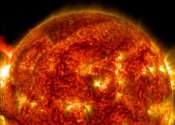Mapping the sun's interaction with Mercury's surface
A new study maps the infall of protons and electrons from the solar wind to geographical location on the surface of Mercury, giving scientists new insight into how interactions with the sun alters the surface and produces ...









